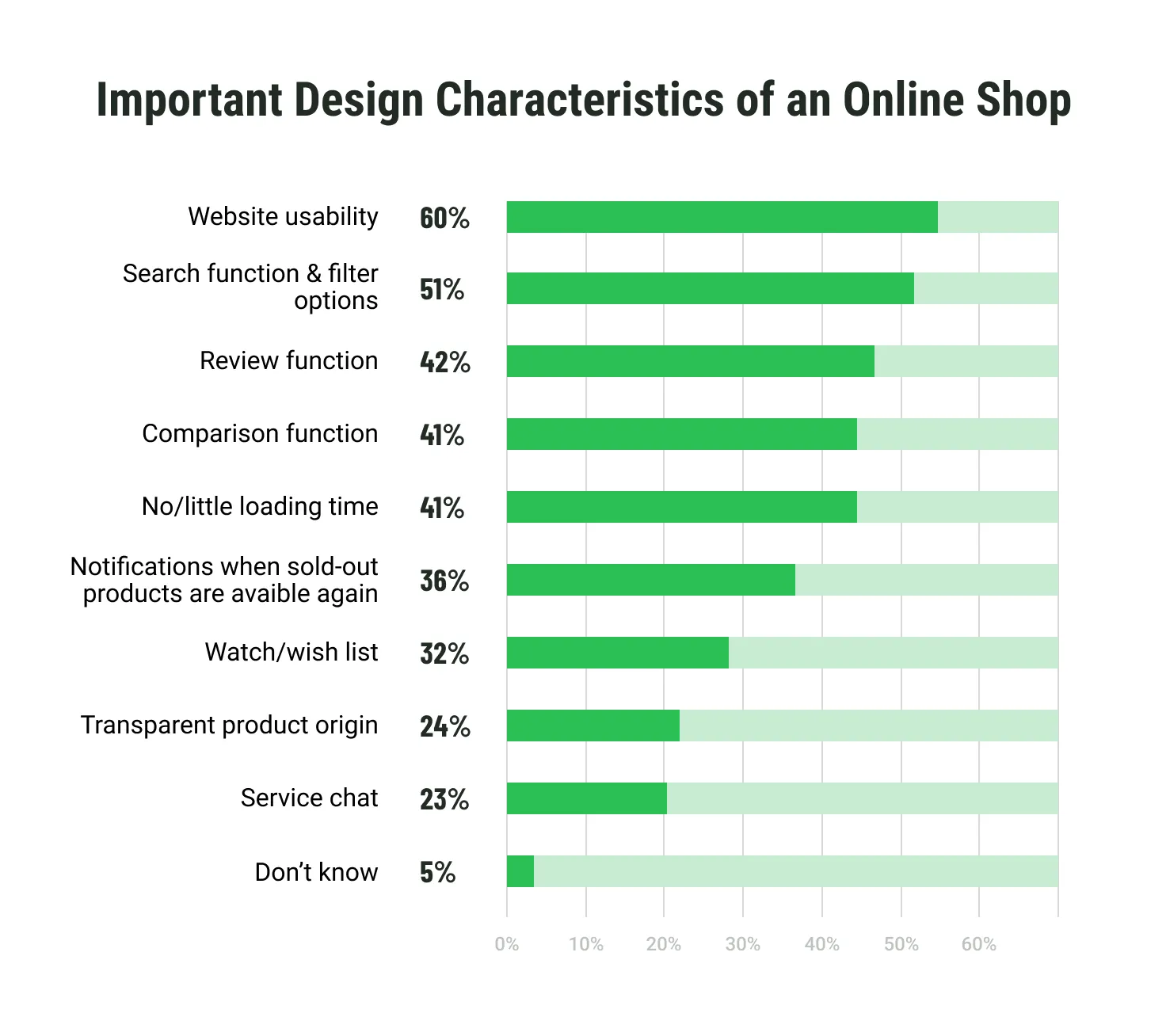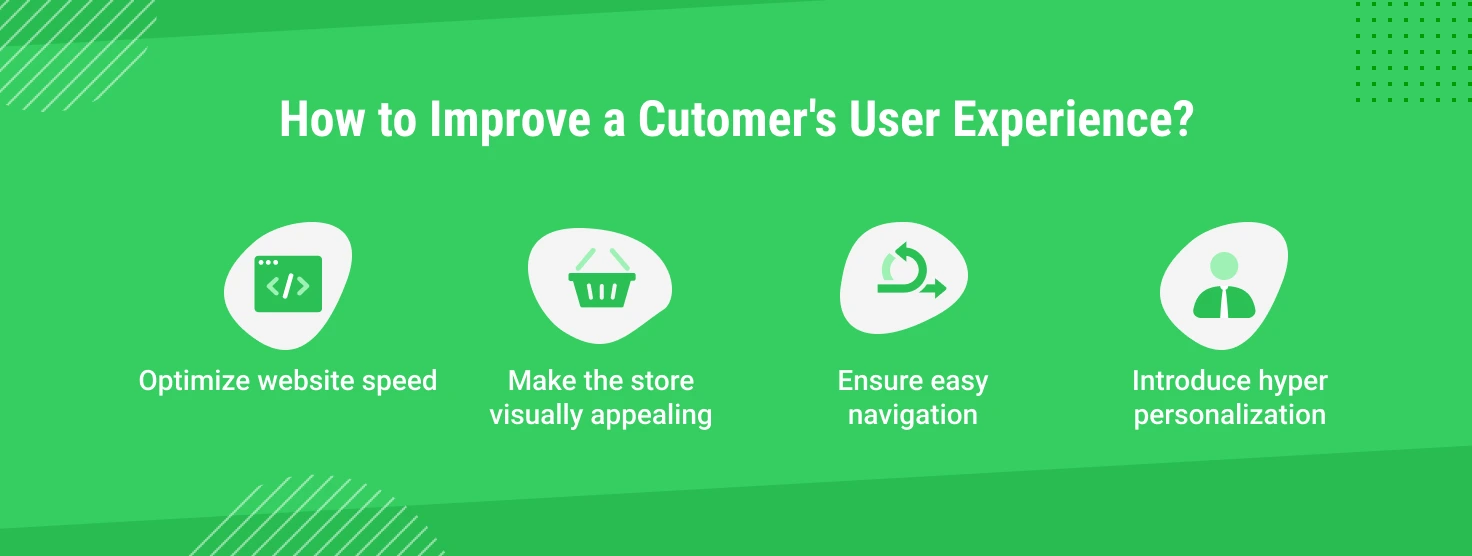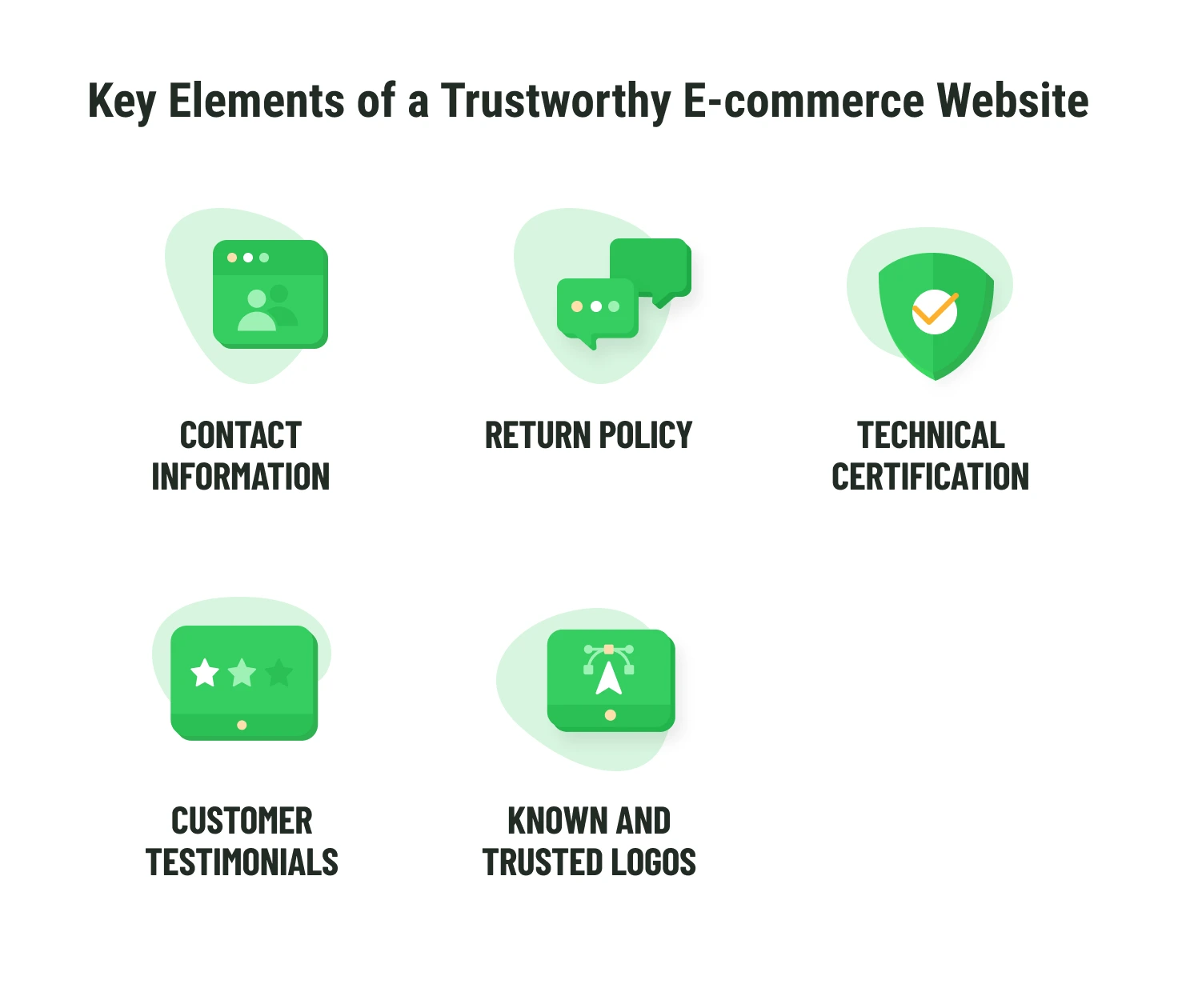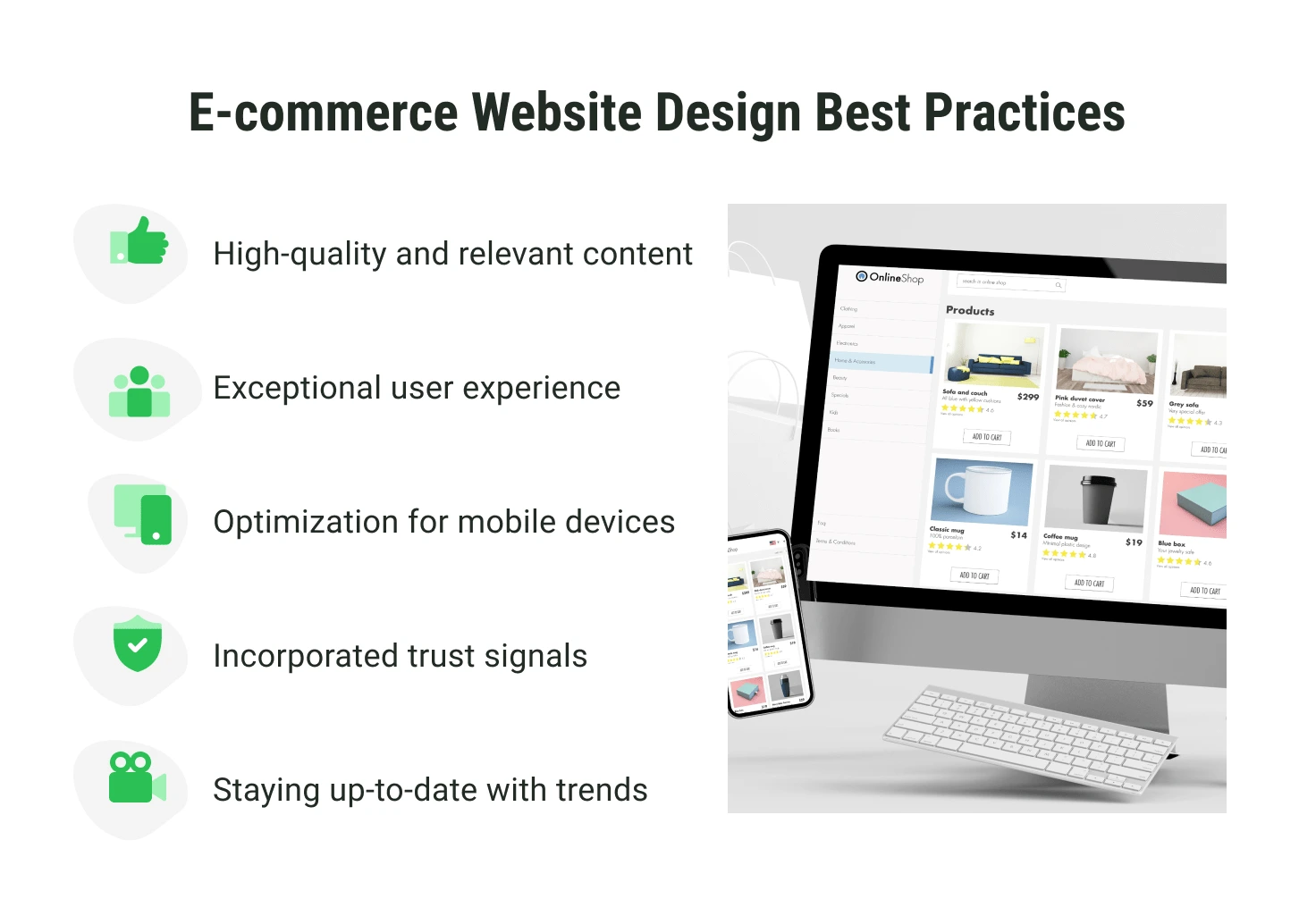E-Commerce Website Design and Development in 2025
Table of contents
- How To Build a Successful E-Commerce Website in 2025?
- Why Is Good Design Essential for an E-Commerce website?
- E-Commerce Website Design Best Practices
- Content
- User experience
- Speed
- Visual appeal
- Easy navigation
- Personalization
- How to Improve Customer's User Experience?
- Key Elements of a Trustworthy E-Commerce Website
- Mobile optimization
- Staying up-to-date with trends
- E-Commerce Website Design Best Practices
- The Bottom Line
- Frequently Asked Questions
- 1. Is there a difference between E-commerce and web development?
- 2. Why is it important to design an E-commerce website well?
- 3. How important is responsive design for an E-commerce website?
- 4. Can you integrate social media into your E-commerce site?
- 5. How is online transaction security ensured on an E-commerce website?
How To Build a Successful E-Commerce Website in 2025?
Launching your own E-commerce business is a thrilling endeavor filled with endless possibilities. But before you jump headlong into the world of online retail, there's a crucial aspect that can determine the fate of your venture: designing your E-commerce website.
In today's digital landscape, where user experience reigns supreme, a poorly designed online store can be detrimental to your success. Research from Baymard Institute shows that the average cart abandonment rate in 2025 hovers around 70%. This means 7 out of 10 potential customers add items to their cart but leave without completing the purchase. While there are many reasons for cart abandonment, a clunky, confusing, or unappealing website design is a major contributing factor.
That's why, in this article, we'll delve deep into the significance of E-commerce website development and design and its direct impact on sales. Drawing from our extensive experience in delivering exceptional design solutions, we'll shed light on why investing in a well-designed E-commerce website is indispensable for success in 2025 and beyond.
Why Is Good Design Essential for an E-Commerce website?
An appealing and distinctive website design has consistently been a crucial factor in achieving success with online sales and marketing endeavors. The significance of such design can be supported by several compelling insights.
- According to WebFX marketing research, your solution’s design directly impacts 75% of your store’s credibility, making it essential to understand and cater to the expectations of your target audience. Surprisingly, you have less than a second to make that crucial first impression.
- An astounding 90% of users are likely to continue their shopping journey due to an exceptional User Experience (UX).
- Statista found that 60% of consumers rate usability as an important design characteristic for an online store.

That means perception is key, and your customer’s perception is a reality that matters. However, what constitutes good website design and how to ensure it? Keep reading to discover.
E-Commerce Website Design Best Practices
The design of your E-commerce store should depend on the needs of your customers. However, certain standards are relevant across diverse industries. When building your online webstore, consider incorporating the following essential elements:
Content
In a survey conducted by Google, 85% of shoppers emphasized the significance of product information and images in influencing their purchasing decisions when choosing between brands or retailers.
High-quality and relevant content keeps visitors engaged on the E-commerce page. Engaging content, including product descriptions, videos, and customer reviews, helps shoppers better understand the products and builds trust, ultimately increasing the likelihood of conversion.
In addition, well thought out content is good for SEO. Search engines often prioritize websites with valuable and informative content, leading to higher organic traffic and potential customer acquisition. So, content with targeted keywords can enhance your E-commerce site's visibility in search engine results.
User experience
Creating a unique and emotionally engaging connection between buyers and products can significantly impact the success of the online business, making it crucial to align your strategies with the emotional triggers and preferences of your target audience. You can ensure this by providing an exceptional user experience. Here are a few concepts that can help you with this.
Speed
No matter how beautiful your website is or what products and prices you offer, your potential customers will never know about it if the speed of your website is low. Based on a recent Kissmetrics infographic, more than 25% of users will abandon a page and opt for a different search result if it takes longer than 3 seconds to load. Slow-loading websites cost retailers $2.6 billion in lost sales each year.
Optimizing website speed enhances user satisfaction, reduces bounce rates, and improves overall conversion rates.
Visual appeal
Visual appeal is your E-commerce website's first chance to make a good impression. A successful design communicates your brand story through unified aesthetics and messaging. Choose product photos, fonts, iconography, and color schemes that resonate with your customers. Be consistent with your design to reflect a cohesive narrative, even as page layouts and features change. This builds trust, recognition, and a strong brand identity.
Easy navigation
Ensure the navigation is intuitive and helps customers find your products quickly and easily.
- Use drop-down menus with clear terms to segment products.
- For sites with numerous products, a prominent search bar on every page speeds up the search process, allowing browsing by categories and specific items.
- Ensure the cart icon is easily accessible, displaying the item count.
- Ensure a clear checkout process flow that usually goes like this: shopping cart - shipping information - shipping method - billing information - payment method - confirmation.
- Create clear menu headers like "Product Category," "About Us," "Bestsellers," "Contact Us", etc., when designing your store.
Personalization
Tailor the user experience based on individual preferences and behaviors.Personalized product recommendations, targeted offers, and relevant content make users feel valued and understood. Hyper personalization takes it further. You can leverage advanced analytics and AI to offer real-time, highly relevant experiences to foster brand loyalty, boost engagement, and increase conversions.
How to Improve Customer's User Experience?
- Optimize website speed
- Make the store visually appealing
- Ensure easy navigation
- Introduce hyper personalization

Trust
Researchers have found that a lack of trust in a website is a factor that contributes to online consumers' reluctance to perform an online transaction. Surprisingly, the number of individuals who avoid online stores because of mistrust is notably high 一 34% of Generation Z don’t trust online stores.
So, when visitors land on your site for the first time, they need assurance that your brand is reliable, your products are of high quality, and their satisfaction is your priority. Here are some trust indicators to incorporate into your website:
- Contact information. Providing clear contact details, including an email, phone number, and mailing address, assures customers that they can easily reach out to a real person behind the business. An "About Us" page adds a human touch, giving customers insights into your brand's story and team members.
- Return policy. A transparent and customer-friendly return policy reduces shopping cart abandonment and instills confidence in potential buyers that they can return products if needed without transaction fees.
- Technical certifications. Utilizing secure payment services with the latest security technology demonstrates your commitment to protecting customer information. Displaying badges or graphics showcasing your security compliance and accepted payment methods reinforces trust.
- Known & trusted logos. If your E-commerce website sells products from big brand names, display their logos to add prestige to your business and establish trust through affiliation with industry leaders.
- Customer testimonials. Customers trust other customers. Positive buying experiences from fellow customers validate a brand's value, effectively reducing resistance and making new potential customers more likely to consider purchasing your product.
Key Elements of a Trustworthy E-Commerce Website
- Contact information
- Return policy
- Technical certification
- Customer testimonials
- Known and trusted logos

Mobile optimization
According to Google insights, 59% of shoppers emphasize the importance of mobile shopping capability when choosing a brand or retailer to make their purchase. A global survey has also discovered that 56% of in-store shoppers utilized their smartphones for shopping or researching items while physically present at a store within the past week prior to completing the survey.
So, ensure your website is user-friendly and responsive across various devices and screen sizes, whether customers browse on a desktop, smartphone, or tablet. It can open doors to a wider audience and drive significant growth for your E-commerce businesses.
For those with sufficient resources and a desire to take their mobile strategy to the next level, creating a mobile application can bring forth exciting opportunities.
Staying up-to-date with trends
Initially, E-commerce stores served as intermediaries, linking customers to sales teams. Nowadays, to gain competitive advantages, E-commerce web designs are constantly progressing and adapting to technological advancements.
These advancements include introducing interactive layouts, dynamic pages, data-driven product recommendations, advanced chatbots, mobile responsiveness, etc. These trends are favored by consumers and can lead to increased customer satisfaction and loyalty.
With over 10 years of experience in E-commerce web design and development, Emerline has not just witnessed all these changes but has been at the forefront, working on the implementation of cutting-edge solutions for our clients. Leveraging the latest technologies and design thinking methodology, we cover a broad spectrum of expertise—from excellent UX/UI designs to modern, state-of-the-art AI and ML integrations. Throughout this decade, we have expanded our E-commerce services to encompass all kinds of platforms, covering everything from consulting to migration to custom development. By exploring and utilizing every emerging trend, we've learned from our own experience that each trend has the potential to become the next industry standard.
Embracing trends also demonstrates that your business is forward-thinking and committed to providing a modern and seamless online shopping experience, which can help build trust with your audience and give you a competitive edge in the market.
E-Commerce Website Design Best Practices
- High-quality and relevant content
- Exceptional user experience
- Optimization for mobile devices
- Incorporated trust signals
- Staying up-to-date with trends

The Bottom Line
The success of each online store starts with the website. A well-designed E-commerce website is essential for building credibility, engaging users, and increasing sales. Key elements such as a robust content management system, high-quality content, exceptional user experience, trust indicators, mobile optimization, and staying up-to-date with design trends play crucial roles in driving E-commerce success.
If you want to develop a good E-commerce solution from scratch or embrace the best E-commerce website design and development practices for your existing E-commerce platform, contact our experts at Emerline. With over 10 years of experience working with E-commerce solutions, we have the expertise and resources to address any challenges you may face or to turn your ideas into fully functional and successful products. Book a free consultation to get started on creating a winning E-commerce website today.
Frequently Asked Questions
In this brief Q&A section, you'll find answers to the most common questions about E-commerce website design and development:
1. Is there a difference between E-commerce and web development?
Yes. Web development is a comprehensive field that includes the building and maintenance of all types of websites and web applications, covering tasks such as design, content creation, development, etc. It is divided into frontend (user-facing elements) and backend (server-side operations) development.
E-commerce development, a specialized area within web development, focuses on creating online shopping platforms. It involves specific elements like shopping cart integration, payment gateways, product management, content management systems, and enhancing the user experience for online stores from catalog representation to checkout processes.
While web development covers a vast range of applications beyond commercial transactions, including informational sites, portals, social networks, and more, E-commerce website development requires a specific set of skills related to online sales strategies, marketing, and the technical aspects of facilitating electronic transactions. It focuses on developing platforms that not only encompass the foundational elements of web development but also include specialized features designed and developed to enhance the online shopping experience.
2. Why is it important to design an E-commerce website well?
Designing an E-commerce website well is crucial for several reasons:
- Design significantly impacts user experience, ensuring that visitors can navigate the site easily, find products quickly, and complete purchases without frustration.
- A well-designed website establishes trust and credibility with customers, showcasing professionalism and attention to detail that reflects positively on the brand.
- Effective design enhances brand identity, helping to differentiate the business in a competitive market.
- Good design can further optimize website performance, improving load times and compatibility across devices, which can boost search engine rankings and increase traffic.
3. How important is responsive design for an E-commerce website?
Responsive design is crucial for E-commerce websites as it significantly improves the user experience (UX) across all devices, ensuring a seamless shopping journey. This adaptability not only makes it easier for customers to interact with the site but also boosts usability and accessibility.
The enhanced UX provided by responsive design can lead to better search engine rankings, as mobile-friendly sites are favored by search engines like Google. This, in turn, drives more traffic and potentially increases conversion rates, as a smooth user experience encourages more engagement and purchases.
In essence, responsive design is vital for the success of an E-commerce platform, impacting everything from visibility to sales.
4. Can you integrate social media into your E-commerce site?
Yes, you can integrate social media into your E-commerce site effectively to boost engagement, traffic, and sales. Features like social sharing buttons, social login options, and showcasing user-generated content enhance the user experience and build community trust.
Embedding social media feeds and utilizing targeted ads and retargeting campaigns increase visibility and personalize interactions. Integrating social media bridges the gap between online shopping and social engagement, significantly contributing to growth.
5. How is online transaction security ensured on an E-commerce website?
Online transaction security on an E-commerce website is ensured through a combination of technologies, protocols, and practices designed and developed to protect both the buyer's and the seller's sensitive information from unauthorized access, fraud, and other cyber threats:
- SSL Certificates for data transfers encryption to protect sensitive information like credit card numbers.
- PCI DSS Compliance to ensure all transactions meet stringent security standards.
- Two-Factor Authentication for an extra verification step, enhancing security.
- Secure Payment Gateways to safely process transactions with built-in security measures.
- Data Encryption to keep stored information secure and unreadable to unauthorized parties.
- Anti-Malware and Anti-Virus Software to protect against threats and maintain system integrity.
- Regular Security Audits to identify and mitigate risks through vulnerability scans.
Updated on Feb 7, 2025





